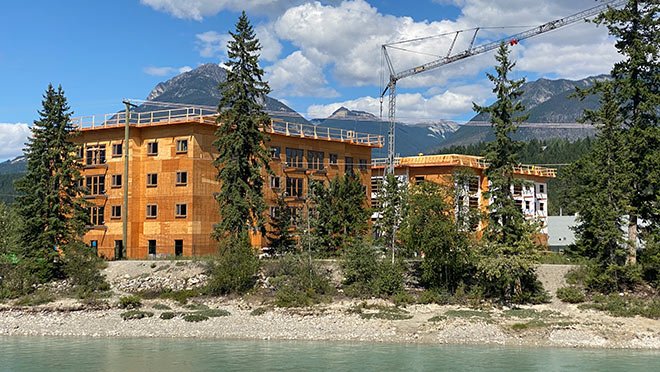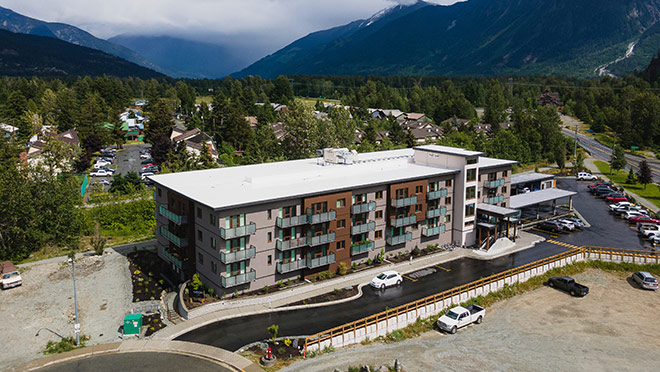Builder finds a cost-effective path to all-electric homes

Apartments in Golden and Pemberton bank on good design, heat pumps
In his quest to cost-effectively build comfortable homes with small energy bills, Rod Nadeau has leaned in on everything from trial-and-error to deep dives into building energy data by a grad student at BCIT. He has also listened closely to the tradespeople swinging hammers and wielding caulking guns at his job sites.
Now he's on a mission to spread the news.
"Five years ago it was still hard to build a high-performance building cost-effectively," he says. "But now, it's dead simple to build one and make it all electric."
As evidence, he presents the latest big project by Vidorra (the development company he co-owns), a mixed-use residential project on the banks of the Kicking Horse River in Golden B.C. called Oso (Spanish for "bear"). Winner of a CleanBC Net Zero Energy Ready (NZER) Challenge prize, Oso features 58 residential units over two buildings, with commercial space on the ground floor and between the two large buildings.
What makes the buildings remarkable is that they're so airtight and efficient that they can avoid the use of fossil fuels for space and water heating, even in Golden, where temperatures dipped as low as -40°C during the B.C.-wide cold snap in December of 2022. The project isn't just a showcase for electric heat pumps. It's the product of lessons learned from Vidorra’s earlier Orion project in Pemberton, which demonstrated that high performance buildings can be built at lower construction costs than similar buildings.
Orion was one of seven Net Zero Energy Ready (NZER) mid-rise residential buildings analyzed by CleanBC's NZER program in 2021 – all of them built to either the BC Energy Step Code's highest Step 4 standard or the Passive House standard. Against projects in Kelowna, Vancouver, and Victoria, Orion was built to the Step 4 standard and proved to be the most cost-effective in a comparison to a baseline cost against similar high-performance buildings.
In the final analysis, the Orion building had a project cost ($148 per square foot) that’s 32% less expensive than similar B.C. buildings built only to Step 1, the lowest standard on the BC Energy Step Code.
Vidorra's newest Zero Net Energy Ready project in Golden, Oso, welcomed homeowners to the first building in November and is due for completion of a building of rental apartments this spring. Among the highlights of Oso are:
- Central heating and cooling to units and corridors via a pair of heat pumps connected to an energy recovery ventilator (ERV) heating and cooling coil, with electric baseboards installed to provide supplemental heating in times of extreme cold.
- Five heat pump hot water heaters in each building.
- A single BC Hydro meter for each building, with unit owners paying for space heating, cooling, and other electricity use through strata fees. This is expected to save $70,000 in construction costs and $8,000 annually in basic charge fees that would have been levied on a per-meter basis by BC Hydro.
- Climate resilience. The building and parking are all located above the 200-year flood plain level, and mechanical cooling is designed to be effective in extreme temperatures. To deal with smoke from wildfires, the ventilation system filters outside air and – in extreme situations – can be fitted with carbon filtration bags, allowing occupants to close windows at times of poor outdoor air quality and still get filtered and cool air from outdoors.
Nadeau says that as a developer, Vidorra needs to disclose to prospective buyers that there's just one BC Hydro meter in the building and that electricity costs are included in the strata fees rather than paid for in a separate BC Hydro bill. And Vidorra has turned that into an advantage.
"Even though heating, cooling and all other electricity use are included in strata fees at Orion, they're about half the price of the building across the street," he says. "It's the same style of building as the one we're comparing against – three-story construction over parking. So at 31 cents a square foot [for strata fees] compared to 60 cents a square foot in the other building, that becomes a marketing benefit."
At 31 cents per square foot, strata fees for a 952 square foot two-bedroom suite at Orion are $295 per month. Nadeau says strata fees at Oso in Golden are initially 38 cents per square foot, with fees for a 1,000 square foot suite at $380.

Hard to sell energy efficiency, easier to sell comfort and affordability
Nadeau says he learned early on in his high-performance buildings adventure that home buyers were (and still are) largely seduced by almost anything other than energy efficiency.
"So years ago, we gave up trying to sell energy efficiency, and we just did it in all our homes," he says. "If you bought a place from us or hired us to build your home, that's just what you got. And a lot of times we didn't even tell our clients what we were doing to achieve high performance. I had one client show up at his house when we had the HRV (heat recovery unit) all roughed in and were putting in triple-pane windows. He was a pretty savvy guy, but he had no idea what he was getting when he bought from us. Instead, he looked at the tile, the kitchen cabinets, and was blown away."
If you're a prospective home buyer, Nadeau would love for you to pay attention to the airtightness of the homes you look at, the mechanical systems and overall performance. But what he's most interested in is how that pays off in affordability, comfort, and lower energy bills.
"To change things, you have to be better, which generally costs more," he says. "And it has to be easier – who wants to do something that's complex? It should be faster to build, which also helps. And it should be cheaper.
"Cheaper is the hardest part. We finally got to cheaper with our Radius and Orion buildings in Pemberton. We developed a system to build our buildings at a discount, and we're operating at about a third of the cost of a Passive House [generally considered to be the highest building envelope standard] for heating. Our units in Pemberton and in Golden, where it's a lot colder than in Vancouver, will heat for $30 to $50 a year."
The apartments at Oso in Golden range in size from 500 to 1,000 square feet, and the central heat pump system is designed to maintain an in-unit temperature of 22°C year-round. "And if someone wants it to be 25°C in the winter, and uses their supplementary baseboard heaters to do it, fine," he says. "That will only cost another $10 a year."
Nadeau is confident Oso will deliver on the forecasted energy costs, because his Pemberton buildings are proof that the system works.
In late June, 2021, the "heat dome" that struck B.C. pushed temperatures in Pemberton as high as 46°C. Nadeau claims that Vidorra's Pemberton buildings "skated through the heat wave like it was nothing", and didn't need to run at full capacity to do it.
"The building got up to 25°C, but we had it back down to 22 by the early evening," he says.
Data from the building's energy monitoring system showed cooling during that heat wave cost an average of $10 per unit, and $30 for the whole summer. And the best part? Few complaints.
"If you're too hot, you're upset and you're going to complain," he says. "If you're too cold, you're going to complain. If you stand beside a window and you're cold, you're going to complain. So our goal is to just not hear from anybody, which tells us there's nothing going on they have to complain about."
Spreading the word to other builders
Nadeau has been busy lately making presentations and hosting webinars in the hope that what he has learned can be passed on to others in the industry.
It's his core belief that as good as the BC Energy Step Code has been for the evolution of high-performance buildings, if the industry can adopt simpler, less complex solutions to the delivery of airtight buildings that run efficiently with heat pumps, the Step Code can accelerate.
A few of the lessons and observations Nadeau likes to pass along include:
- Consider central heat pump systems, which take the task of maintenance and operation out of the hands of unit occupants, and into the hands of experts hired to run them well.
- Favour simple solutions over complex ones that might require costly retraining of all involved.
- If tradespeople complain about the complexity of a task, or if they have a new idea, listen to them. "In Golden, I watched a guy use a new product and prep a window in five minutes, and it's done better than I thought was possible. I made sure that it's a product we're using on our next design."
- Paying extra for higher-efficiency HRVs and ERVs is worth the investment. "Why buy a 55% efficient HRV when an 80% HRV is available?," he says.
"We've been monitoring the performance of Orion for two years now, and at Radius, our other building in Pemberton, for five years," says Nadeau. "We have the data, so it's not rocket science."